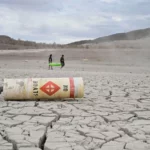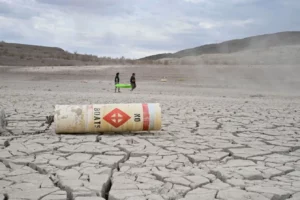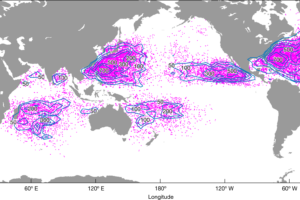- This weekly round-up brings you key climate change stories from the past seven days.
- Top environment stories: A global biodiversity deal is agreed; California aims to cut CO2 emissions by 85%; New technology brings hope for coral reefs.
1. News in brief: Top climate change stories to read this week
Severe winter weather is set to hit millions across the US this week. Arctic air settling over several states is forecast to drop temperatures to as low as -40C. The National Weather Service warned that “wind chills of this magnitude can cause frostbite in less than five minutes”, reported the Guardian. This so-called ‘bomb cyclone’ places an estimated 50 million Americans under windchill alerts.
California regulators have approved a plan to reduce the state’s carbon-dioxide emissions by 85% by 2045. It could involve electrifying much of the state’s energy usage, deploying carbon capture technology and reducing petroleum usage by 90%.
Scientists in the United States have announced a breakthrough in fusion energy that could help curb climate change if companies can scale up the technology to a commercial level in the coming decades. Nuclear experts say the achievement is a major stepping stone, but there is much more science to be done before fusion becomes commercially viable.
The UK government has announced a set of new legally binding environmental targets to protect air quality, green spaces and to clean up rivers. “These targets are ambitious and will be challenging to achieve – but they will drive our efforts to restore our natural environment, protect our … green spaces and marine environment,” said Environment Minister Thérèse Coffey.
The U.S. Department of Energy says it will commit $3.7 billion to finance projects to remove planet-warming carbon from the atmosphere and meet the nation’s goal of net-zero greenhouse gas emissions by 2050. The funds will help finance four direct air capture hubs to draw carbon dioxide from the air and store it underground.
A SpaceX rocket has sent NASA’s first global water mission into orbit. The survey of Earth’s surface waters will provide data that can help shed more light on the impacts of climate change.
The Japanese government is proposing to introduce a carbon levy on fossil fuel importers to encourage the companies to curb carbon dioxide emissions. The carbon pricing scheme, which could come into force towards the end of the decade, would involve a levy on businesses and an emissions trading scheme between companies.
Scientists working on Australia’s Great Barrier Reef have successfully trialled a new method for freezing and storing coral larvae they say could eventually help rewild reefs threatened by climate change.
2. Global biodiversity deal is passed at COP15 summit
A United Nations summit has approved a landmark deal to protect global biodiversity and target billions of dollars towards conservation projects. The Kunming-Montreal Global Biodiversity Framework, reflecting the joint leadership of China and Canada, is the culmination of four years of work.
Delegates were able to build consensus around the deal’s most ambitious target of protecting 30% of the world’s land and seas by the end of the decade, a target known informally as 30-by-30. More than a million species could disappear by the end of the century in what scientists have called a sixth mass extinction event. As much as 40% of the world’s land has been degraded, and wildlife population sizes have shrunk dramatically since 1970.
“Now that countries have signed this deal, we need businesses to tackle this crisis and shift to a nature-positive economy,” says Akanksha Khatri, author of The New Nature Economy Report and Head of nature and Biodiversity at the World Economic Forum. “Doing so will create jobs, growth and food security while also helping us tackle the effects of climate change. Our research shows that $44 trillion, the equivalent of about half global GDP, is at risk due to nature-loss, with the biggest threat to the agriculture, forestry, food and construction sectors. Moreover, a nature-positive economy would create 395 million jobs and $10 trillion in business value each year by 2030.”

Image: IPBES.
The deal also directs countries to allocate $200 billion per year for biodiversity initiatives from both the public and private sectors. Developed countries will provide $25 billion in annual funding starting in 2025 and $30 billion per year by 2030. However, some African delegations say they are still unhappy about the funding arrangements of the final deal.
3. More on climate change on Agenda
Eight countries have already reached net zero emissions, helping combat climate change, according to the latest data. Most are small, with limited industrial sectors and prioritize ecological protection measures.
1.5 million people move to urban areas each week, creating a massive demand for housing and putting a strain on natural resources. Daniel Zimmer, Director of Sustainable Land Use at Climate-KIC, says switching to timber sourced from sustainably managed, climate-smart forests could play an instrumental role in mitigating climate change and its worst impacts.
Carbon dioxide emissions have soared in recent decades and our global food system accounts for about a quarter of them. Although there is growing awareness about how eating meat impacts the environment, Chiara Cecchini, Director of Business Development at Savor, says more needs to be done to encourage a plant-based diet.
Source : World Economic Forum











Add Comment